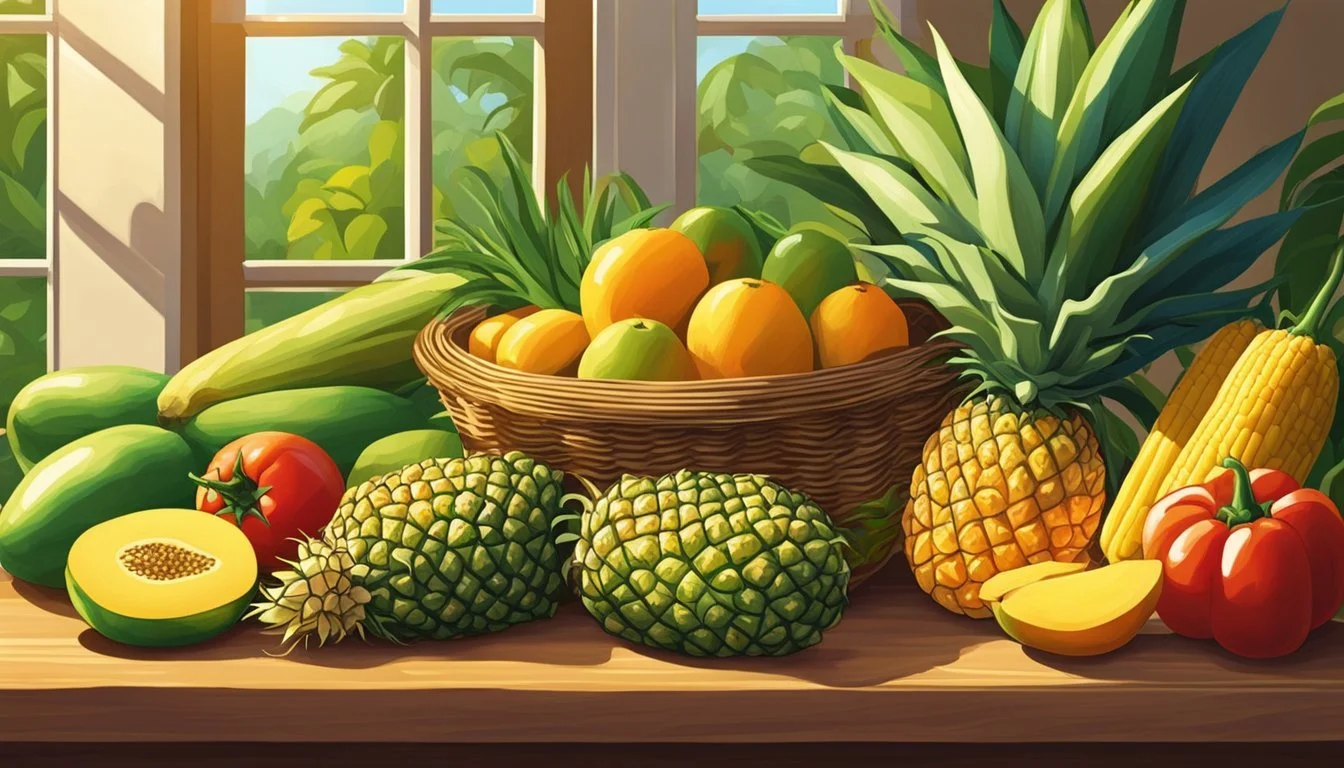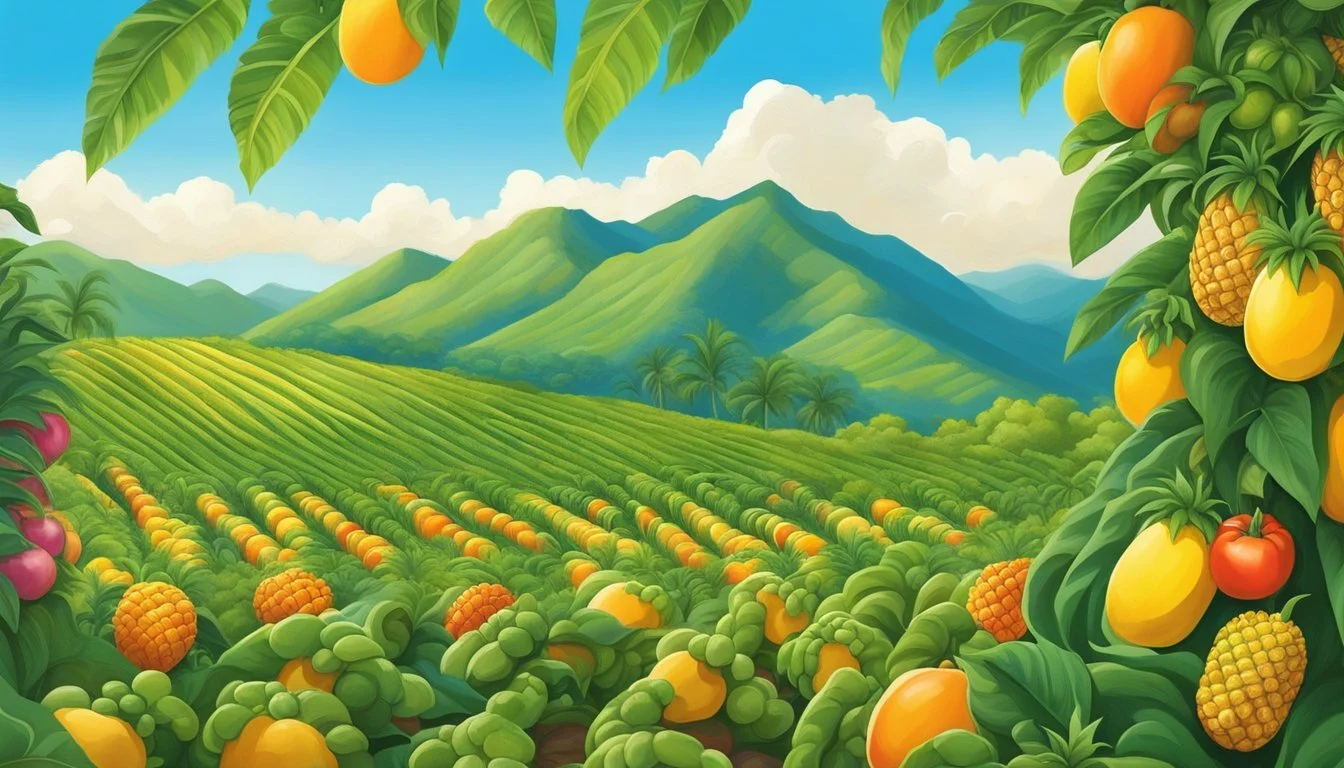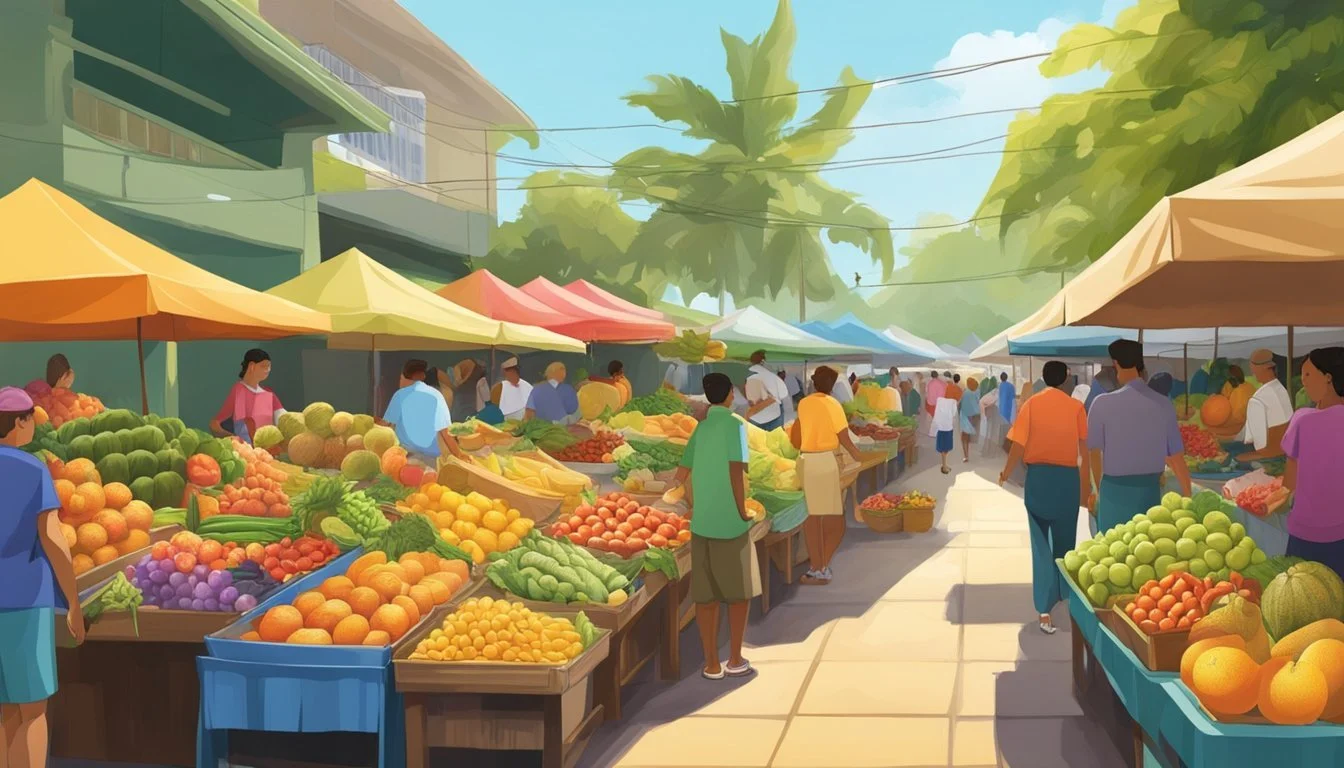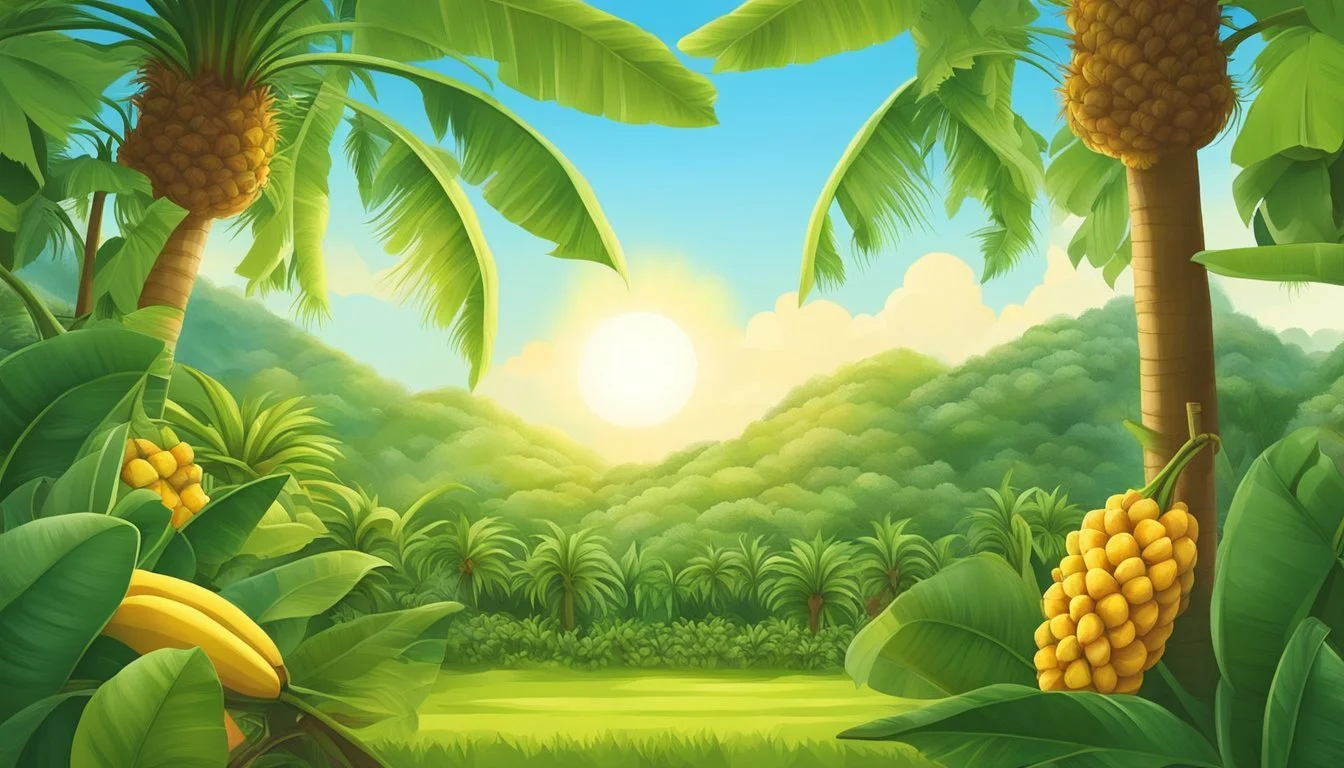Hawaii Seasonal Fruit & Vegetables in August
A Guide to Fresh Produce
This Article is Part of our Hawaii Seasonal Fruit & Veg Calendar
In the lush landscapes of Hawaii, August is a time of abundance for both fruits (What wine goes well with fruit?) and vegetables. The islands' unique climate provides year-round growing conditions, but summer months like August bring some of the most diverse and flavorful produce to the fore. Farmers' markets and local grocers are brimming with a wide variety of tropical fruits that capture the essence of the island’s rich volcanic soil and warm sunshine.
Seasonal fruits such as mangoes reach their peak in Hawaii during August. Mangoes are not just a fruit in Hawaii; they are a seasonal celebration, with varieties like Hayden, Raposa, and Pirie being among the favorites. These mangoes are known for their vibrant red and yellow hues, signifying ripeness and a hint of green that promises a balance of sweetness and tang.
Vegetables also thrive during this time, with a notable abundance of avocados. Hawaii's avocados, which are in season from September through April, are still widely available and enjoyed in August. The climate of the islands ensures that these avocados are rich and creamy, perfect for both traditional dishes and innovative culinary creations. This period marks a time of rich harvests and is an excellent opportunity for both locals and visitors to experience the flavors that make Hawaiian produce truly exceptional.
Overview of Hawaii's Seasonal Produce
Hawaii's unique location and climate yield a plethora of produce that varies throughout the year. August is notable for its abundance of select fruits and vegetables that thrive in the islands' summer conditions.
Climate's Impact on Harvest
Hawaii's climate plays a pivotal role in determining its seasonal harvests. The consistent warm temperatures and fertile volcanic soil allow for year-round growth of many crops. However, specific fruits and vegetables peak in August, benefiting from the summer's slightly drier and warmer weather compared to other months. Rainfall patterns and microclimates across the islands also influence when and where certain produce is best harvested.
Popular Hawaiian Fruits
In August, Hawaii's fruit selection is particularly rich. Tropical fruits such as mangoes are at the end of their season, typically available from May through September. The following list highlights some of the popular fruits during this time:
Mangoes (May - September)
Papayas (year-round)
Lychee (May - August)
Passion Fruit (Lilikoi) (year-round)
These fruits are not only staples in local diets but also sought-after by visitors for their freshness and quality.
Vegetables Unique to the Hawaiian Islands
The islands' vegetables are as diverse as their fruits. August sees the continuation of certain varieties that flourish throughout the year as well as those that are specific to the summer months. Vegetables that stand out during this season include:
Okra (year-round, with summer being the peak season)
Sweet Potatoes (year-round)
Taro (year-round)
Eggplant (summer months)
This period is ideal for experiencing the unique tastes and textures of Hawaiian-grown vegetables, many of which have deep cultural significance and are featured prominently in Hawaiian cuisine.
Fruits in Season
August in Hawaii teems with a variety of ripe, sweet fruits. This period is ideal for sampling the state’s abundant tropical and exotic offerings.
Pineapples and Varieties
Hawaii is renowned for its pineapples, which reach peak ripeness in August. Known for their exceptional sweetness and juiciness, varieties such as the ‘Maui Gold’ are sought after for their low acidity and rich flavor.
Maui Gold Pineapple: Exceptionally juicy with a high sugar content
Traditional Hawaiian Pineapple: Bold and tangy, with a classic pineapple taste
Citrus Fruits and Avocados
This month also delights with a range of citrus fruits, including the increasingly popular apple bananas, known for their sweeter, apple-like taste. Avocados are bountiful; they’re creamy and rich, perfect for savory and sweet dishes alike.
Apple Bananas: Sweet, apple-tasting bananas that are smaller and plumper
Avocados: Creamy texture, rich in healthy fats
Exotic Fruits
For those seeking the truly unique, August is an opportune time to explore exotic fruits like lychees, guavas, and passion fruit. Mangoes are exceptionally sweet, having soaked up the Hawaiian sun, while papayas are perfectly ripe and ready for enjoyment.
Lychees: Juicy with a floral taste and a fragrant aroma
Guavas: A fragrant fruit with a unique flavor that’s both sweet and tangy
Passion Fruit: Known locally as liliko'i, offering a tart, aromatic experience
Mangoes: Sweet, rich in flavor, and bursting with tropical essence
Papayas: Soft, sweet fruit commonly enjoyed at breakfast
Beyond these, one can find mountain apples—pear-shaped fruits with a watermelon-like texture—and coconuts, which are not only refreshing but also integral to many local dishes. August's generous sunlight ensures that these fruits are especially sweet and enjoyable.
Vegetable Harvest
In August, Hawaii's agricultural landscape yields a robust variety of fresh produce. The tropical climate and rich soil are conducive to growing a multitude of vegetables, including a range of root vegetables, greens, tomatoes, and peppers, each with their own specific harvest time.
Root Vegetables and Greens
Root Vegetables: In the warmth of August, root vegetables like sweet potatoes and ginger thrive, offering their flavorful additions to the table. They are typically ready for harvest and can be found fresh in the local markets.
Sweet Potatoes: Harvested when the leaves start to yellow.
Ginger: Mature enough for a harvest that provides a spicy and fresh flavor.
Greens: Greens also peak in August, with varieties such as kale and spinach being readily available. They are harvested when their leaves are tender and full-grown, a perfect addition for nutritious salads or cooked dishes.
Kale: Picked when the leaves are about the size of a hand.
Spinach: Harvested when leaves are lush and deep green.
Seasonal Tomatoes and Peppers
Tomatoes: August is a prime month for harvesting tomatoes in Hawaii. They are picked at their peak ripeness, exhibiting a vibrant red hue and a juicy, rich flavor.
Cherry Tomatoes: Small and sweet, frequently picked from the vine.
Heirloom Tomatoes: Larger and varied in colors, known for their unique taste.
Peppers: The warm Hawaiian climate in August is ideal for harvesting a variety of peppers, ranging from sweet to spicy.
Bell Peppers: Available in multiple colors, picked when they are firm to the touch.
Chili Peppers: Harvested when they reach the desired level of heat.
Local Fruit in Culinary Uses
Hawaii's local fruits serve as vital ingredients in traditional culinary practices, enhancing both dishes and beverages with tropical flavors.
Traditional Hawaiian Dishes
The Hawaiian diet prominently features native fruits, both in their raw form and as components in various recipes. Poi, a staple food, is often accompanied by slices of ripe bananas or papayas, adding a sweet contrast to the dish's tangy taste. Laulau, a dish traditionally made by wrapping pork and fish with taro leaves, is sometimes served with sides of pineapple or mango to introduce a refreshing, sweet element.
'Ulu (Breadfruit) is featured in savory dishes, often steamed, baked, or mashed, akin to potatoes.
Coconut is frequently used; coconut milk extracted from the flesh imparts a rich, creamy texture to traditional dishes like haupia, a coconut milk-based dessert.
Desserts and Drinks
Local fruits are integral to Hawaiian desserts and drinks, with their distinct flavors and natural sweetness.
Desserts:
Coconut again takes center stage in haupia, which is a jiggly and creamy pudding.
Lilikoi (passionfruit) is common in desserts, either as a fresh topping or in the form of a jelly or jam.
Guava is fashioned into cakes, pies, and sweet spreads, celebrated for its fragrant flavor profile.
Drinks:
Pineapple and guava juice are refreshing on their own or as part of a smoothie blend.
Mango and papaya are often pureed into smoothies or shaken into cocktails, sometimes with a dash of lime to enhance their tropical flavor.
Non-alcoholic beverages like Pog, a juice made from passionfruit, orange, and guava, quench thirst and reflect Hawaii's rich agricultural landscape.
Using these fruits in Hawaiian culinary practices does not only add sumptuous flavors but also carries cultural and historical significance. Whether in solid or liquid form, they play an indispensable role in connecting food with the islands' heritage.
Fruit and Vegetable Shopping in Hawaii
When shopping for fruits and vegetables in Hawaii in August, one has a wealth of locally-grown options available from farmers markets to grocery stores.
Farmers Markets and Local Stands
Farmers markets in Hawaii are a bustling hub for fresh, local produce where shoppers can find a variety of fruits and vegetables that are in season. They serve as the direct link to the island’s farmers, providing produce such as mangosteen, lychee, and Hawaiian avocados. Popular markets like the KCC Farmers Market offer not only selections of fresh fruit but also an authentic Hawaiian market experience. At these local stands, customers will often find:
Avocados: In season from September through April
Lychee: Best found in the summer months
Tips for Purchasing at Grocery Stores
When purchasing fresh produce at Hawaiian grocery stores, it's key to look for signs of locally sourced items to ensure freshness and support local agriculture. Shoppers should seek out native species or locally grown variants to experience the true flavors of the island. Grocery stores often label local items clearly, and one can usually find a wide assortment of fruits and vegetables that are in peak season during August. For example, grocery stores may offer:
Fresh pineapples and blueberries
A variety of leafy greens suited for the Hawaiian luau
At these grocery stores, produce like carrots and celery, which grow well in the island's climate, are typically available year-round and are great accompaniments to any meal with their fresh and local taste.
Sustainable Practices and Seasonal Eating
In Hawaii, sustainable practices in August revolve around consuming what's locally available, thus supporting the island's unique agricultural environment and reducing the environmental impact.
Supporting Local Farms
Hawaii's local farms flourish by offering an abundance of fruit and vegetables that mature in the state's tropical climate. Ono Organic Family Farm, for example, is noted for its array of organic products, from tropical fruit to cacao. Patrons directly contribute to the viability of these local businesses when they opt for locally-sourced produce, which, in turn, bolsters the community's economy and reduces food mileage—a significant component of a food item's carbon footprint.
Local Farms in Hawaii (August Offerings)
Fruits: Mango, Papaya, Pineapple
Veil of August Vegetables: Salad Greens, Okra
Patronizing these farms not only assures the consumer of the freshness of their food but also encourages agricultural diversity and resilience.
Benefits of Seasonal Eating
Adopting a diet that includes seasonal produce can yield high-quality fruits and vegetables packed with optimal flavor and nutrients. During August in Hawaii, this includes a wide variety of both tropical fruits and versatile vegetables. This practice compliments the natural growing cycle and minimizes reliance on imported goods, which often require extensive resources to transport and store.
Consumers who eat seasonally typically enjoy:
Enhanced Nutrition: Foods consumed in their optimal state tend to offer more vitamins and minerals.
Environmental Protection: Lower transportation energy lowers overall carbon emissions.
Incorporating seasonal fruit and vegetables into one's diet represents a tangible action towards environmental sustainability, directly reflecting the harmony between local consumption habits and the preservation of natural resources.
Integrating Hawaiian Produce into Your Diet
Incorporating Hawaiian produce into one's diet can be both a flavorful journey and a beneficial choice for health. The islands offer a plethora of fruits and vegetables that lend themselves to nutritious eating, especially in August when the harvest is abundant.
Healthy Snacking Options
For healthy snacking, one might reach for Hawaiian guava or lilikoi (passion fruit); both are in season and provide a boost of vitamin C. Long beans, available from local farms, make for a crunchy, fiber-rich snack. Locally grown bananas are another excellent option—they're portable and packed with potassium. Try these options for a midday treat:
Fresh guava slices
Lilikoi fruit bowls
Chilled long beans with a light dip
Banana smoothies with other Hawaiian fruits
Breakfast with a Tropical Twist
Breakfast can be transformed by infusing it with Hawaiian produce. Mango, ripe and in season from July to October, is a sweet addition to morning yogurt or oatmeal. One can also enjoy a local favorite, Hawaiian pineapple (hala kahiki), alongside eggs for a savory-sweet combination.
Here are some breakfast ideas incorporating local produce:
Mango oatmeal topped with toasted coconut
Pineapple and papaya fruit salad
Smoothie bowls featuring banana and lilikoi
Scrambled eggs with diced pineapple and avocado
By integrating Hawaiian fruits and vegetables into their diet, one can easily enjoy the fresh, vibrant flavors of the islands while contributing to a health-conscious lifestyle.
Monthly Guide to Hawaiian Produce
Hawaii’s diverse climate allows for a variety of fruits and vegetables to grow throughout the year. In particular, August marks the height of abundance for many island favorites.
What to Expect Each Month
January: The winter month brings the later harvests of citrus fruits, along with avocados. One can find fresh 'ulu (breadfruit), a staple in traditional Hawaiian diets.
April: By April, the islands see the beginning of mango season. Several varieties become available, with the Rapoza and Pirie mangoes being notably popular.
August: The summer's heat peaks along with the production of many fruits and vegetables. Mangoes are at their prime, with the Hayden variety being particularly red, yellow, and flavorful. The Annual Mango Festival also celebrates this beloved fruit. Sweet corn is harvested during this period, offering freshness straight from the fields.
Mangoes: Hayden, Rapoza, Pirie
Corn: Fresh and sweet, often at its peak
Each month presents a shift in availability, with fruits such as mangoes ripening significantly between April and August, while seasonal shifts from January to April introduce new varieties to markets.









